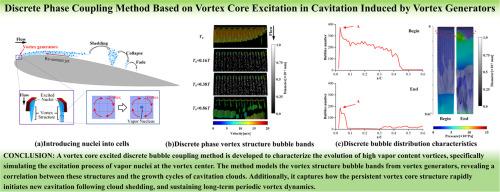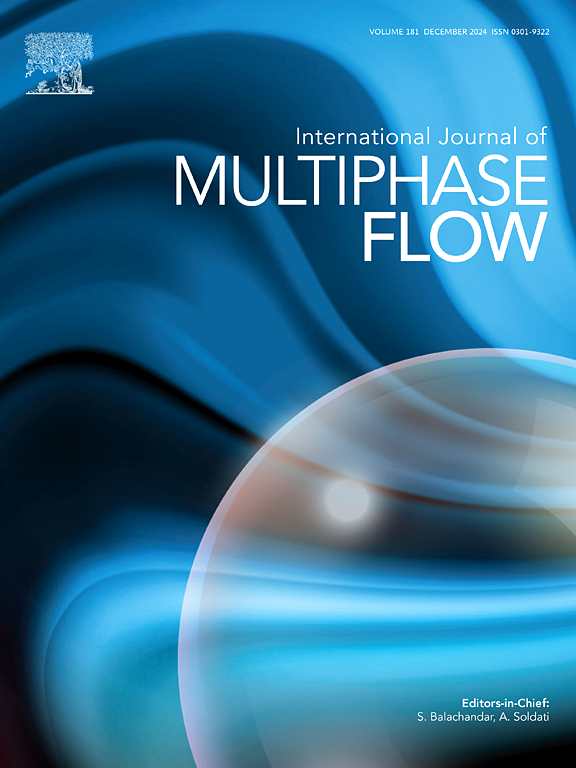Discrete phase coupling method based on vortex core excitation in cavitation induced by vortex generators
IF 3.8
2区 工程技术
Q1 MECHANICS
International Journal of Multiphase Flow
Pub Date : 2025-09-17
DOI:10.1016/j.ijmultiphaseflow.2025.105455
引用次数: 0
Abstract
Cavitation is prevalent in various types of fluid machinery. Vortex generators, as key components governing cavitation inception and development, possess small-scale features that challenge conventional numerical methods in accurately capturing vortex-induced flow details. This paper presents a novel discrete bubble coupling numerical methodology that effectively simulates cavitation inception induced by vortex generators and captures high vapor content vortex structures at discrete bubble scales. Furthermore, this work analyzes the periodic characteristics of high vapor content vortex structures caused by the vortex generators in experiments and compares experimental findings with simulation results. The results demonstrate that high vapor content vortex structures are accompanied by the periodic shedding of cavitation clouds, and rapid cavitation inception occurs following re-entrant jet cutting off the cavitation clouds. Numerically, the key structural features of high vapor content vortex structures were captured which aligned the experimentally observed periodic variations. Simultaneously, the discrete phase bubble collapse fluctuation exhibits a time lag relative to the continuous phase vapor volume fraction fluctuation, with a phase lag of approximately 0.225 cycles, attributed to the reduced vapor volume after re-entrant jet cutting off attached cavitation clouds.

涡发生器空化中基于涡芯激励的离散相位耦合方法
气蚀现象在各类流体机械中普遍存在。涡发生器作为控制空化产生和发展的关键部件,其具有小尺度特征,这对传统的数值方法在准确捕捉涡致流动细节方面提出了挑战。本文提出了一种新的离散气泡耦合数值方法,有效地模拟了由涡发生器引起的空化开始,并在离散气泡尺度上捕获了高蒸汽含量的涡结构。此外,本文还分析了实验中由涡发生器引起的高蒸汽含量涡结构的周期性特征,并将实验结果与模拟结果进行了比较。结果表明,高蒸汽含量涡结构伴随着空化云的周期性脱落,在再入射流切断空化云后,快速空化开始。数值模拟得到了高蒸汽含量涡结构的关键结构特征,与实验观测到的周期变化一致。与此同时,相对于连续相蒸汽体积分数波动,离散相气泡崩溃波动表现出一定的时滞,相位滞后约为0.225个周期,这是由于再入射流切断附着的空化云后蒸汽体积减小所致。
本文章由计算机程序翻译,如有差异,请以英文原文为准。
求助全文
约1分钟内获得全文
求助全文
来源期刊
CiteScore
7.30
自引率
10.50%
发文量
244
审稿时长
4 months
期刊介绍:
The International Journal of Multiphase Flow publishes analytical, numerical and experimental articles of lasting interest. The scope of the journal includes all aspects of mass, momentum and energy exchange phenomena among different phases such as occur in disperse flows, gas–liquid and liquid–liquid flows, flows in porous media, boiling, granular flows and others.
The journal publishes full papers, brief communications and conference announcements.

 求助内容:
求助内容: 应助结果提醒方式:
应助结果提醒方式:


